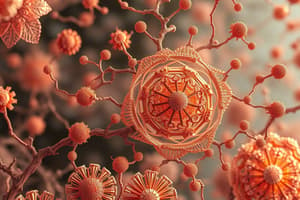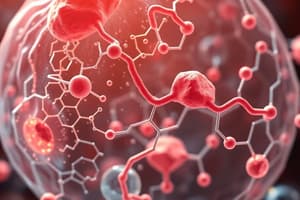Podcast
Questions and Answers
¿Cuál es el propósito principal de las vías metabólicas catabólicas?
¿Cuál es el propósito principal de las vías metabólicas catabólicas?
- Maximizar el uso de energía celular.
- Minimizar la captura de energía para las células.
- Descomponer moléculas orgánicas complejas en bloques más simples. (correct)
- Sintetizar macromoléculas complejas como los lípidos.
¿En qué parte de la célula tiene lugar la glucólisis en las células eucariotas?
¿En qué parte de la célula tiene lugar la glucólisis en las células eucariotas?
- Mitocondria
- Citoplasma (correct)
- Retículo endoplasmático
- Núcleo
¿Qué moléculas se generan como subproductos durante la glucólisis?
¿Qué moléculas se generan como subproductos durante la glucólisis?
- ATP y NADH (correct)
- Aminoácidos
- ADN y ARN
- CO2 y H2O
¿Cuál de las siguientes NO es una macromolécula compleja producida a través de las vías metabólicas?
¿Cuál de las siguientes NO es una macromolécula compleja producida a través de las vías metabólicas?
¿Cuál es el papel del ATP en las células?
¿Cuál es el papel del ATP en las células?
¿Qué implica la catabolización de macromoléculas complejas?
¿Qué implica la catabolización de macromoléculas complejas?
¿Qué es el ciclo del ácido cítrico?
¿Qué es el ciclo del ácido cítrico?
¿Qué son las vías anabólicas responsables de hacer?
¿Qué son las vías anabólicas responsables de hacer?
¿Qué es un ejemplo de síntesis anabólica en las células?
¿Qué es un ejemplo de síntesis anabólica en las células?
¿Cómo pueden las células equilibrar sus vías catabólicas y anabólicas?
¿Cómo pueden las células equilibrar sus vías catabólicas y anabólicas?
¿Cómo se regula la actividad de las vías metabólicas a nivel enzimático?
¿Cómo se regula la actividad de las vías metabólicas a nivel enzimático?
¿Cómo se integra el metabolismo con otros procesos celulares?
¿Cómo se integra el metabolismo con otros procesos celulares?
Study Notes
Cellular Metabolism: An Overview of Metabolic Pathways
Cellular metabolism is a complex series of reactions that occur within the cells of living organisms to sustain life. These reactions are organized into distinct pathways, each with its unique role in either maximizing the capture of energy or minimizing its use. Metabolic pathways are essential for maintaining cellular and whole-body function, providing energy for various cellular processes and the biosynthesis of complex macromolecules like nucleic acids, proteins, polysaccharides, and lipids.
Catabolic Pathways
Catabolic pathways involve the breakdown of complex organic molecules into simpler building blocks, often releasing energy in the process. This energy is stored in forms like ATP, which serves as the primary energy currency for cells. Catabolism is the degradation of complex macromolecules into simpler molecules such as carbon dioxide, water, and ammonia.
Glycolysis
Glycolysis is a ten-step process that occurs in the cytoplasm of eukaryotic cells and the cytosol of prokaryotic cells. It involves the breakdown of one glucose molecule into two pyruvate molecules, generating ATP and NADH as byproducts. The process can be anaerobic, producing only a small amount of ATP, or aerobic, generating a larger amount of ATP through the citric acid cycle and the electron transport chain.
Citric Acid Cycle (Krebs Cycle)
The citric acid cycle, also known as the Krebs cycle, is a series of reactions that occur in the mitochondria of eukaryotic cells and the cytoplasm of prokaryotic cells. Acetyl CoA, produced from the breakdown of fatty acids or glycolysis, enters the cycle and undergoes a series of reactions, eventually generating ATP, NADH, and FADH2 as byproducts.
Anabolic Pathways
Anabolic pathways are responsible for synthesizing complex macromolecules from simpler building blocks. These pathways require energy input and are essential for maintaining cellular and whole-body function.
Biosynthesis of Nucleic Acids, Proteins, Polysaccharides, and Lipids
Various anabolic pathways are involved in the synthesis of these complex macromolecules. For example, the biosynthesis of nucleic acids, such as DNA and RNA, involves the synthesis of nucleotides from simpler precursors like ribose and deoxyribose, as well as the formation of purine and pyrimidine bases. Protein synthesis involves the assembly of amino acids into polypeptide chains, which can then be modified to form functional proteins. Glycosylation, the addition of sugars to proteins and lipids, is another anabolic process that plays a crucial role in the function of these molecules.
Balancing Catabolic and Anabolic Pathways
Cells need to balance their catabolic and anabolic pathways to maintain their levels of critical metabolites and ensure sufficient energy is available. This balance can be influenced by changes in concentrations of key metabolites, such as glucose, fatty acids, and ATP. In times of energy scarcity, cells may synthesize glucose from other materials or send fatty acids into the citric acid cycle to generate ATP. Conversely, in times of abundance, excess glucose is converted into storage forms like glycogen, starches, and fats.
Regulation of Metabolic Pathways
The activity of metabolic pathways is regulated at various levels, including the transcription of genes encoding enzymes, post-translational modifications of enzymes, and allosteric regulation of enzyme activity. Some enzymes can be activated or inhibited by binding to specific molecules called activators or inhibitors, respectively. Feedback inhibition is a regulation mechanism in which the products of a metabolic pathway act as inhibitors of their own synthesis, ensuring that the cell does not overproduce specific metabolites.
Integration of Metabolism with Other Cellular Processes
Metabolism is now recognized as an integral part of various cellular processes, including cell signaling, gene expression, and cellular differentiation. Recent research has highlighted the importance of understanding metabolic pathways in the context of human diseases and has stimulated a renaissance of interest in small-molecule therapeutics for various conditions.
Studying That Suits You
Use AI to generate personalized quizzes and flashcards to suit your learning preferences.
Description
Explora este resumen detallado sobre el metabolismo celular y las vías metabólicas, desde los procesos catabólicos de descomposición de moléculas hasta las vías anabólicas de síntesis de macromoléculas complejas. Aprende sobre la importancia de equilibrar estas vías para mantener el suministro de energía y los metabolitos críticos en las células.




